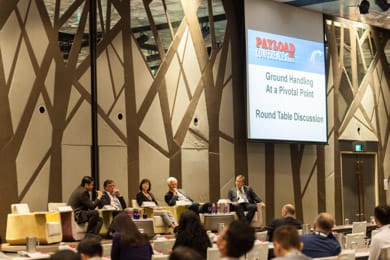News, ULD CARE News
ULD CARE Latest News October 2015
A great deal has happened in the two months since the publication of our last newsletter.
At the top of the list sits the ULD CARE Annual Conference which was held this year in Bangkok and in a groundbreaking move co-located with the Air Cargo Handling conference (photos and presentations from the Bangkok event are now available in the Conference Archives of our website).
We do not have any formal way of measuring the benefits from having these two events side-by-side but to those of us who were there it certainly felt that this had been a good idea. ACH delegates were invited to attend a joint session with the ULD CARE members while Urs Wiesendanger introduced ULD CARE via the presentation of the SOS ULD video and participated in a panel organized by ACH.
For those newsletter readers who were not present at the conference, one of the important steps that were achieved in Bangkok was the signature of an MOU between IATA and ULD CARE whereby each organization recognizes the other. With this in place, we foresee considerably expanded opportunities for collaboration between the two organizations leading to an enhanced coverage of ULD affairs for the industry at large.
Following the successful format we introduced in 2014 in Mainz this year’s event also had a strong focus on developing a series of actions to be worked on over the following 12 months. These initiatives fall into two basic categories: one being the creation of practical aids to assist members in carrying out ULD operations and the other is to create communications tools to promote safe and efficient ULD operations.
 One recently implemented initiative is that ULD CARE now has a LinkedIn page. We encourage all our members to sign up to this page which can be found by clicking this LinkedIn icon.
One recently implemented initiative is that ULD CARE now has a LinkedIn page. We encourage all our members to sign up to this page which can be found by clicking this LinkedIn icon.
With so many different activities of interest happening these days, the plan is to use LinkedIn as a way of keeping our members up-to-date as events occur rather than having to wait for the bi-monthly newsletter.
ULD and ULD CARE have been getting lots of coverage in recent weeks. The IATA ULD Regulatory Forum was held in Montréal at the end of September. This was an extremely successful event with some very interesting presentations from various industry angles including the FAA on AC 120-85A, NTSB on lessons to be learnt from NAC 102, and a very comprehensive presentation from IATA’s Data Manager, Peter Hunt, on loading errors. We also covered some new territory by holding a joint session with the Lithium Battery Mitigation event. This gave us an opportunity to present a much broader audience with developments on FRC and FCC and from the feedback this went down extremely well.
 And finally earlier this month, Bob Rogers made a presentation to introduce ULD CARE at the Payload Asia conference in Singapore which once more highlighted the SOS-ULD video. Bob also participated in two round table discussions one of which titled: Ground Handling at a Pivotal Point.
And finally earlier this month, Bob Rogers made a presentation to introduce ULD CARE at the Payload Asia conference in Singapore which once more highlighted the SOS-ULD video. Bob also participated in two round table discussions one of which titled: Ground Handling at a Pivotal Point.
With the conference season pretty much completed for 2015, it seems appropriate to say that ULD and ULD CARE have received far more publicity than in any previous year.
Now for this month’s featured articles:
Introducing FAA AC 120-85 A
Looking outwards, probably the most significant event for all our readers will be the implementation by the FAA of AC120 – 85A in the coming months, and so one article in this newsletter is given to this subject.
Mitigation of Lithium Battery Risk – the story continues to unfold
The second article provides an update on the Lithium Battery conversation, given that this is such a fast moving subject it seems necessary to have another article at this stage
All about ULD contours
The third article takes an in-depth look at the whole issue of ULD contours, a subject that might seem simple enough but which in fact, if not properly understood and implemented, can cause all sorts of operational and safety problems.



Comments are closed.